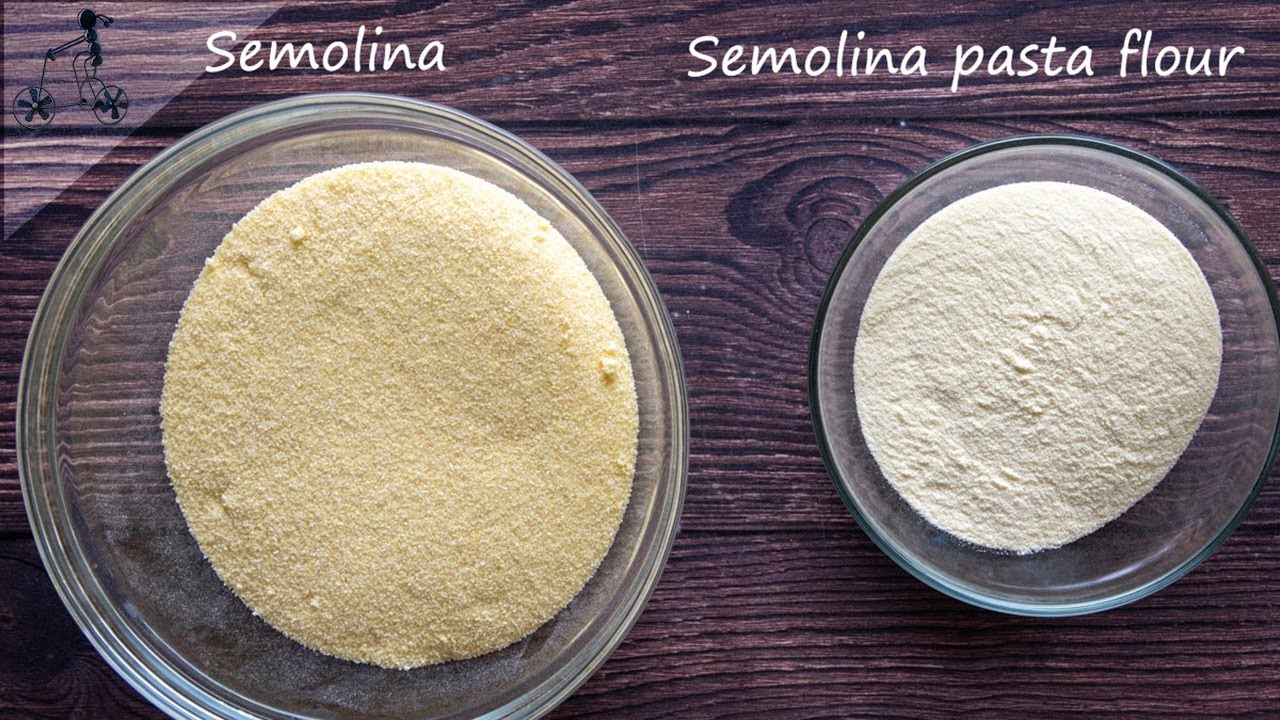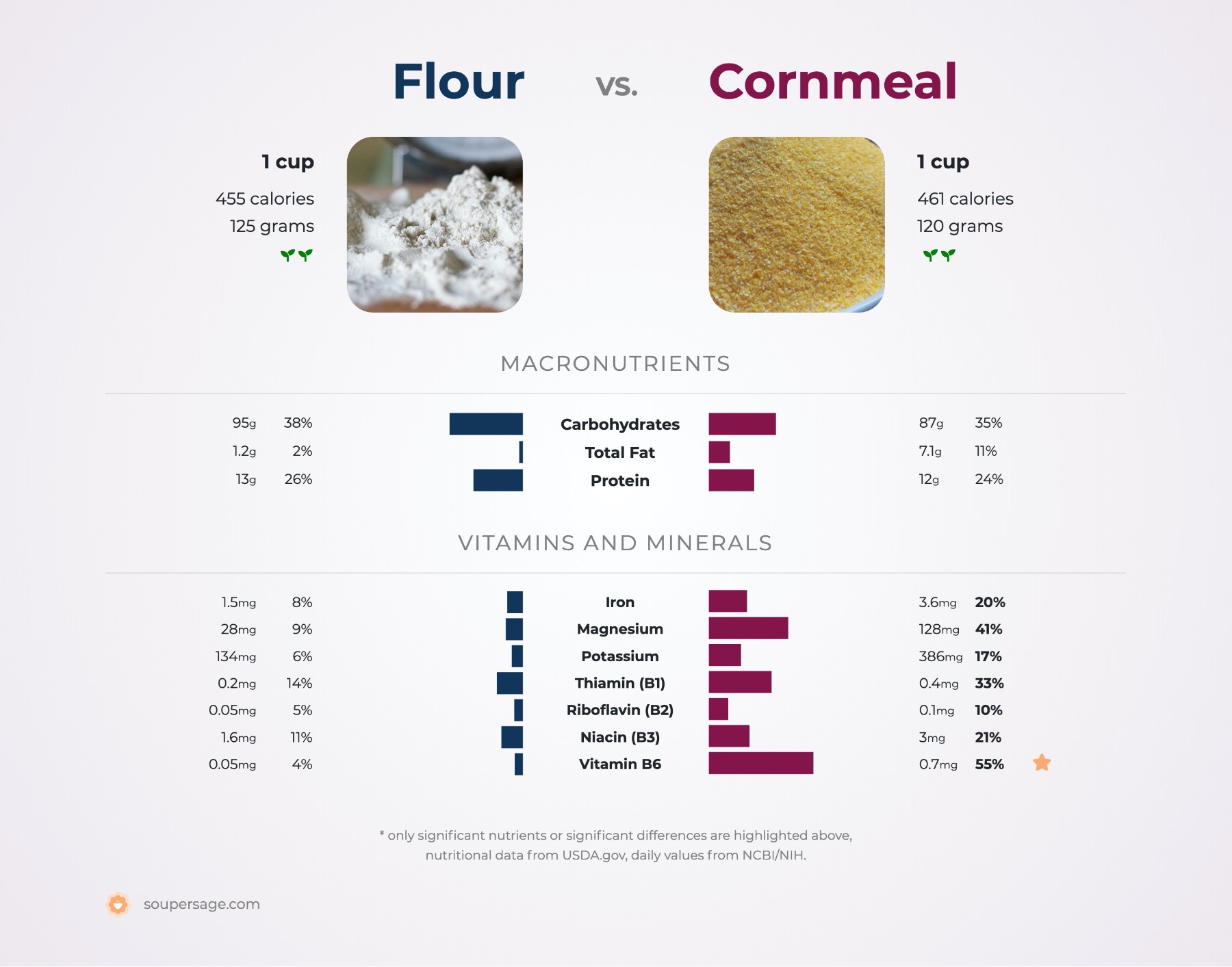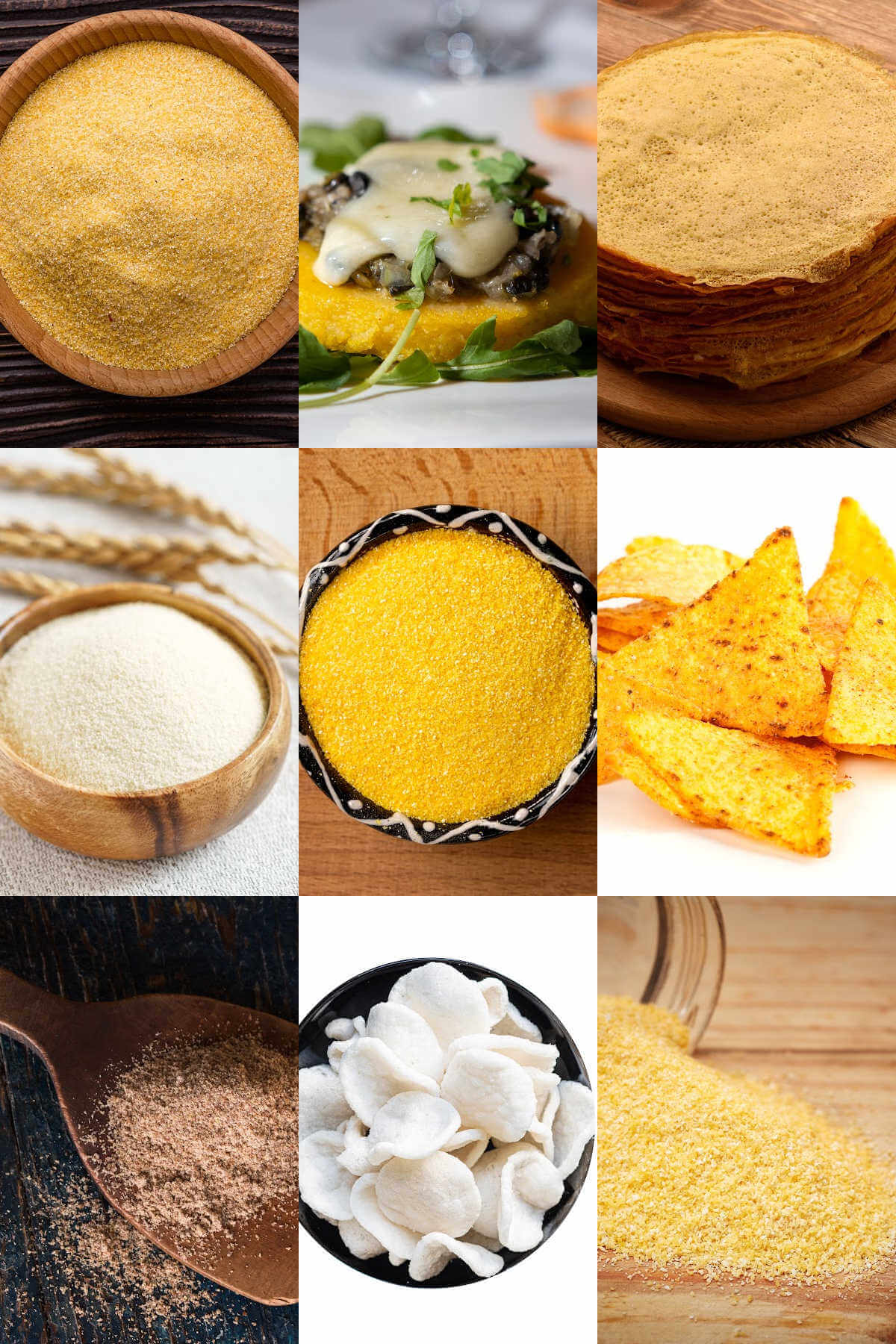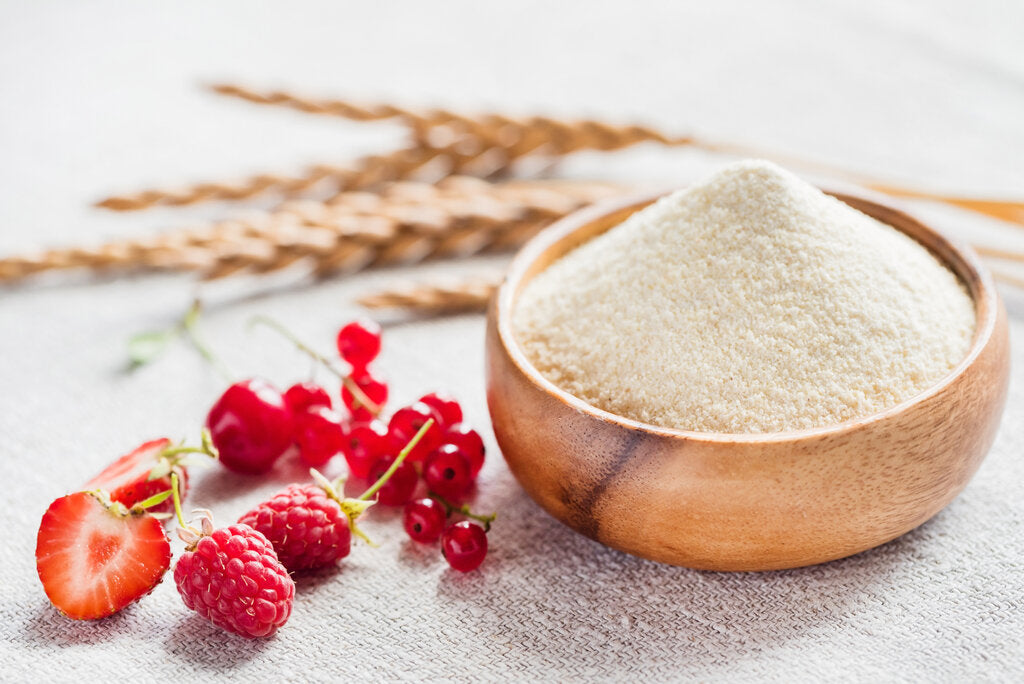Introduction

In this comparison article, we will delve into the differences between semolina and cornmeal, two popular types of flour that are widely used in various culinary applications. While both are derived from durum wheat and have a coarser texture than regular wheat flour, there are distinct characteristics that set them apart. We will explore their origins, production processes, nutritional values, and culinary uses. Additionally, we will examine their texture, flavor profiles, and recommended cooking methods. By the end, you will have a clearer understanding of semolina and cornmeal and be equipped to choose the appropriate flour for your recipes.
Overview Of Semolina And Cornmeal
Semolina and cornmeal are both types of flour that are derived from durum wheat. Semolina has a coarse texture and is commonly used in making pasta, bread, and pizza dough. It is known for its high gluten content, which gives it a chewy and springy texture. On the other hand, cornmeal is made from ground corn and has a slightly sweet and nutty flavor. It is often used in making cornbread, polenta, and breading for fried foods. Both semolina and cornmeal have their own unique characteristics and are used in a variety of culinary applications.
Distinguishing Characteristics Of Semolina And Cornmeal
Semolina and cornmeal have their own unique characteristics that set them apart. Here are some key differences between the two:
- Texture: Semolina has a coarse texture and a gritty feel, whereas cornmeal has a finer texture and is smoother to the touch.
- Color: Semolina typically has a pale yellow color, while cornmeal can vary in color, ranging from white to yellow to even blue.
- Flavor: Semolina has a mild and nutty flavor, while cornmeal has a slightly sweet and earthy taste.
- Culinary uses: Semolina is commonly used in making pasta, bread, and pizza dough, while cornmeal is often used in recipes for cornbread, polenta, and breading for fried foods.
These distinguishing characteristics make semolina and cornmeal suitable for different culinary applications and can offer unique flavor and texture profiles to dishes.
Semolina Flour

Semolina flour is a type of flour that is made from durum wheat. It has a coarse texture and a pale yellow color. The production process involves grinding the endosperm of the durum wheat, leaving behind the bran and germ, resulting in a finely ground flour.
Semolina flour is commonly used in making pasta, bread, and pizza dough. It is known for its high gluten content, which gives these foods a chewy texture and helps them retain their shape during cooking. Semolina flour is also rich in protein and dietary fiber, making it a nutritious choice for baking and cooking.
Semolina Flour: Origin And Production Process
Semolina flour has its origins in the milling of durum wheat, a hard variety of wheat that is widely cultivated in Mediterranean countries. The production process involves grinding the endosperm of the durum wheat, while removing the bran and germ. This results in a coarsely ground flour with a pale yellow color and a gritty texture. The flour is then further refined to create a finer grade known as “semola rimacinata.” This meticulous production process ensures that semolina flour retains its high gluten content, making it ideal for pasta, bread, and pizza dough.
Semolina Flour Nutritional Value And Culinary Uses
Semolina flour is packed with nutritional value, making it a healthy choice for your culinary creations. It is a good source of protein, providing essential amino acids for muscle growth and tissue repair. Additionally, semolina flour is rich in complex carbohydrates, which provide sustained energy. It also contains important vitamins and minerals such as iron, magnesium, and B vitamins.
Culinary-wise, semolina flour is most commonly used in making pasta dough, giving it a perfect texture and chewy bite. It is also used in the production of breads, pizza dough, and certain desserts like puddings and cakes. Its unique texture and versatility make semolina flour a go-to ingredient for a variety of delicious dishes.
Cornmeal Flour

Cornmeal flour is a type of flour made by grinding dried corn kernels into a fine powder. It is commonly used in cooking and baking, especially in traditional dishes such as cornbread, corn muffins, and tortillas. Cornmeal flour comes in different varieties, including fine, medium, and coarse grind, each having its own texture and culinary uses. It has a slightly sweet and nutty flavor, which adds a distinct taste to recipes. Cornmeal flour is also a good source of essential nutrients like fiber, vitamins, and minerals, making it a nutritious choice for your meals.
Cornmeal Flour: Types And Varieties
There are several types and varieties of cornmeal flour available, each with its own unique characteristics and culinary uses. The main distinction lies in the grind size, which can vary from fine to medium to coarse.
- Fine grind cornmeal flour is silky smooth and perfect for baking delicate cakes and pastries.
- Medium grind cornmeal flour is commonly used for making cornbread and pancakes.
- Coarse grind cornmeal flour has a hearty texture and is ideal for crispy coatings on fried foods or the base of pizza crusts.
In addition to the grind size, there are also variations such as white cornmeal flour and yellow cornmeal flour, which differ in color and flavor.
Cornmeal Flour: Culinary Applications And Benefits
Cornmeal flour has a wide range of culinary applications and offers several benefits. It is commonly used to make cornbread, pancakes, and muffins, giving them a distinct corn flavor and texture. Coarse grind cornmeal flour is perfect for creating a crispy coating on fried foods like chicken or fish. It can also be used as a base for pizza crusts, adding a hearty and rustic element to the dish. Additionally, cornmeal flour is gluten-free, making it a great alternative for those with gluten sensitivities. It is rich in vitamins and minerals, including Vitamin A and iron, which contributes to a healthy diet. The versatility and nutritional profile of cornmeal flour make it a valuable ingredient in any kitchen.
Texture And Flavor

Semolina and cornmeal have distinct differences in texture and flavor. Semolina flour, made from durum wheat, has a finer texture compared to cornmeal. It is more granular and has a slightly gritty consistency. On the other hand, cornmeal, made from dried corn, has a coarser texture and a sandy feel. In terms of flavor, semolina has a mild earthy taste with a slightly nutty undertone. In contrast, cornmeal has a sweeter taste reminiscent of cornstarch. These differences in texture and flavor contribute to the unique characteristics of dishes made with semolina or cornmeal.
Texture Comparison Between Semolina And Cornmeal
Semolina and cornmeal have distinct differences in texture. Semolina flour, made from durum wheat, has a finer and softer texture compared to cornmeal. It is more granular and has a slightly gritty consistency. On the other hand, cornmeal, made from dried corn, has a coarser texture and a sandy feel. The coarser texture of cornmeal adds a nice crunch to dishes, while the finer texture of semolina creates a smoother mouthfeel. These textural differences play a significant role in the final outcome and overall eating experience of dishes made with semolina or cornmeal.
Flavor Profiles Of Semolina And Cornmeal
Semolina and cornmeal have distinct flavor profiles that can greatly impact the taste of a dish. Semolina flour, made from durum wheat, has a mild and slightly nutty taste. It adds a subtle sweetness and richness to baked goods like bread and pasta. On the other hand, cornmeal, made from dried corn, has a distinct sweet and earthy flavor. It adds a rich, corn-like taste to dishes like cornbread and polenta. Both flours contribute unique flavors that can enhance the overall taste of various recipes.
Cooking Methods

There are specific cooking methods that work best for semolina and cornmeal. For semolina, the ideal cooking technique is boiling, as it helps pasta maintain its shape and texture. Semolina can also be used to make desserts like halva or as a thickening agent in soups and stews. On the other hand, cornmeal is commonly used for baking or frying. It is perfect for making cornbread, polenta, or coating foods like fish or chicken before frying. Both flours have versatile cooking methods that can enhance the taste and texture of various dishes.
Best Cooking Techniques For Semolina
When it comes to cooking semolina, the best technique is boiling. This method helps pasta made from semolina maintain its shape and texture, resulting in a perfectly al dente bite. Semolina can also be used to make delicious desserts like halva or utilized as a thickening agent in soups and stews. Its versatility extends to various cooking methods, making it a versatile choice for both sweet and savory dishes. So whether you’re making pasta, dessert, or adding thickness to a dish, boiling is the way to go.
Recommended Cooking Methods For Cornmeal
Cornmeal can be used in a variety of cooking methods, allowing you to explore its versatility in the kitchen. Here are some recommended cooking methods for cornmeal:
- Baking: Cornmeal is commonly used in baking to add a crunchy texture and nutty flavor to bread, muffins, and biscuits. It can also be used as a coating for fried foods like chicken or fish.
- Polenta: Cornmeal is the main ingredient in traditional Italian polenta. It is cooked with water or broth until it thickens and becomes creamy, making it a perfect side dish or base for stews and braised meats.
- Cornbread: Cornmeal is essential for making classic cornbread. The coarser texture of cornmeal gives the bread a rustic feel. It can be served as a side dish or enjoyed on its own with butter or honey.
- Cornmeal Porridge: Similar to polenta, cornmeal can be used to make a creamy and comforting porridge. This is especially popular in Caribbean and African cuisine, where it is often flavored with spices like cinnamon or nutmeg.
By using these recommended cooking methods, you can make the most of cornmeal and enjoy its unique flavor and texture in various dishes.
Conclusion

In conclusion, both semolina and cornmeal are unique flours with distinct characteristics. Semolina, made from durum wheat, is known for its coarse texture and nutty flavor, making it a popular choice for pasta and bread. On the other hand, cornmeal, derived from corn, has a finer texture and a slightly sweeter taste, making it versatile for baking, making polenta, cornbread, and porridge. While they have their own uses, both flours can be used interchangeably in certain recipes, offering a range of textures and flavors. Explore the possibilities and experiment with these flours to enhance your culinary creations.
Key Differences Between Semolina And Cornmeal
Semolina and cornmeal have several key differences that set them apart.
- Origin: Semolina is made from durum wheat, while cornmeal is derived from corn.
- Texture: Semolina has a coarser texture compared to the finer texture of cornmeal.
- Flavor: Semolina has a nutty and slightly sweet flavor, while cornmeal has a distinct corn flavor.
- Culinary Uses: Semolina is often used in pasta, bread, and desserts like semolina pudding, while cornmeal is popular for making cornbread, polenta, and porridge.
- Gluten Content: Semolina contains gluten, making it unsuitable for those with gluten intolerance or celiac disease, while cornmeal is gluten-free.
Considering these differences, it’s important to choose the right flour based on your specific culinary needs and dietary restrictions.
Popular Recipes Using Semolina And Cornmeal
Popular recipes that use semolina flour include homemade pasta, such as fettuccine and gnocchi, as well as desserts like semolina cake and halva. Semolina is also commonly used to make crispy bread crusts for pizzas and breadsticks. Some other popular recipes using semolina are semolina porridge and semolina pancakes.
In contrast, cornmeal is the star ingredient in classic cornbread, cornmeal pancakes, and southern-style cornmeal fried fish. It is also used to make polenta, a comforting Italian dish that can be served creamy or grilled. Cornmeal is a versatile ingredient that adds a delicious texture and flavor to recipes like corn fritters and cornmeal cookies.
These recipes highlight the unique qualities of both semolina and cornmeal, showcasing their versatility and ability to enhance a variety of dishes in different cuisines.
FAQ About Semolina Vs Cornmeal: Comparing Different Flours
Q: What is semolina and cornmeal?
A: Semolina is a flour made from durum wheat, while cornmeal is made from ground maize.
Q: How do semolina and cornmeal differ in texture?
A: Semolina is coarser in texture compared to cornmeal, which is finer.
Q: Can semolina and cornmeal be used interchangeably in recipes?
A: While both can be used for certain dishes like making pasta or bread, they have distinct flavors and textures that may not always be interchangeable.
Q: Which one is more commonly used in savory dishes?
A: Semolina is often used in savory dishes like couscous, pasta, and bread, while cornmeal is commonly used in dishes such as cornbread and polenta.
Q: Are there nutritional differences between semolina and cornmeal?
A: Semolina is higher in protein and fiber compared to cornmeal. Cornmeal, on the other hand, is rich in carbohydrates and lower in protein.
Q: Can individuals with gluten intolerance consume semolina and cornmeal?
A: Individuals with gluten intolerance should avoid semolina as it is a wheat product. Cornmeal, being gluten-free, can be a safer option for these individuals.
Q: Which flour is more versatile in cooking?
A: While both semolina and cornmeal have their unique properties, cornmeal tends to be more versatile in cooking due to its gluten-free nature and ability to be used in a variety of dishes.

Marine Bay Restaurant received the International Food Culture Award 2019 as the Best Szechuan & Hunan Restaurant, enjoying a reputation in North America. Renowned for the tunnel, authentic, and cheap. Known as “Human Taste First Garden,” 2013 Vancouver culinary first book named “Best Chuan Xiang Outlets,” significant temperature and China Eastern Airlines designated outlets.